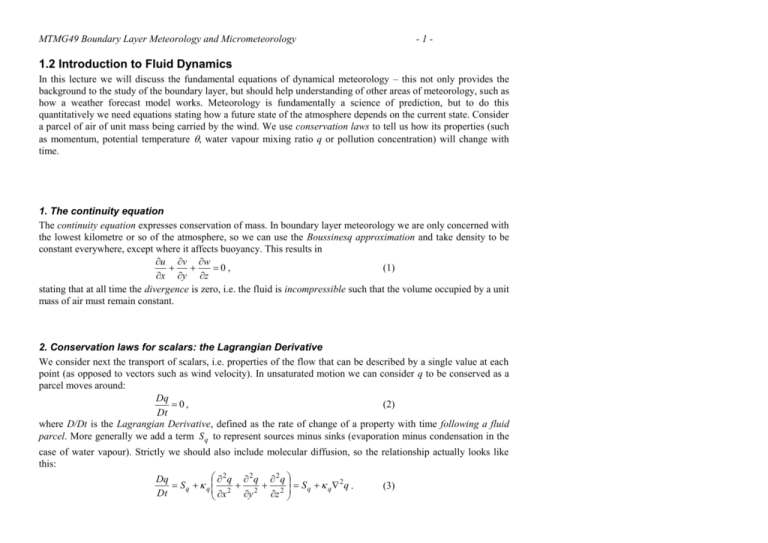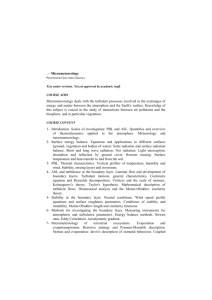1.2 Fluid Dynamics
advertisement

MTMG49 Boundary Layer Meteorology and Micrometeorology -1- 1.2 Introduction to Fluid Dynamics In this lecture we will discuss the fundamental equations of dynamical meteorology – this not only provides the background to the study of the boundary layer, but should help understanding of other areas of meteorology, such as how a weather forecast model works. Meteorology is fundamentally a science of prediction, but to do this quantitatively we need equations stating how a future state of the atmosphere depends on the current state. Consider a parcel of air of unit mass being carried by the wind. We use conservation laws to tell us how its properties (such as momentum, potential temperature , water vapour mixing ratio q or pollution concentration) will change with time. 1. The continuity equation The continuity equation expresses conservation of mass. In boundary layer meteorology we are only concerned with the lowest kilometre or so of the atmosphere, so we can use the Boussinesq approximation and take density to be constant everywhere, except where it affects buoyancy. This results in u v w 0, (1) x y z stating that at all time the divergence is zero, i.e. the fluid is incompressible such that the volume occupied by a unit mass of air must remain constant. 2. Conservation laws for scalars: the Lagrangian Derivative We consider next the transport of scalars, i.e. properties of the flow that can be described by a single value at each point (as opposed to vectors such as wind velocity). In unsaturated motion we can consider q to be conserved as a parcel moves around: Dq (2) 0, Dt where D/Dt is the Lagrangian Derivative, defined as the rate of change of a property with time following a fluid parcel. More generally we add a term S q to represent sources minus sinks (evaporation minus condensation in the case of water vapour). Strictly we should also include molecular diffusion, so the relationship actually looks like this: 2q 2q 2q Dq Sq q 2 2 2 Sq q 2q . (3) x Dt y z MTMG49 Boundary Layer Meteorology and Micrometeorology -2- The second term on the right hand side represents the effect of the random motion of molecules to smooth out sharp gradients in q. The three second-derivatives can be written succinctly as 2 q , referred to as the Laplacian of q. q is the diffusion coefficient (or diffusivity) of water vapour. Sketch 1: Why is the diffusion term of this form? Note that q is very small (2.310-5 m2 s-1 at 10C) and so is only really important at a water surface where the air is saturated but the humidity falls very sharply to the ambient value within a few millimetres. In adiabatic motion the Lagrangian derivative of is zero, but more generally it is given by D (4) S 2 , Dt where is the thermal diffusion coefficient and has a value of 2.010-5 m2 s-1 at 10C. S represents effects that warm and cool the air parcel, such as absorption and emission of radiation, and latent heating by evaporation and condensation. This equation originates from the first law of thermodynamics, and expresses conservation of energy. Expressions for other scalars, such as the concentration of ozone, can be written in a similar way. 3. The Equations of Motion The equations of motion in fluid dynamics are simply Newton’s second law of motion applied to fluids. We can take the same approach as we took for scalars for each component of the velocity vector. So for u we have an expression for the acceleration of our air parcel in the x direction: Du (5) Fu 2u , Dt where (Greek letter “nu”) is the kinematic viscosity (i.e. the molecular diffusion coefficient for momentum) of air and has a value of 1.410-5 m2 s-1 at 10C. Fu is simply the sum of the various forces per unit mass acting on our parcel in the x direction, but can be thought of as the “sources and sinks” of momentum per unit mass. MTMG49 Boundary Layer Meteorology and Micrometeorology -3- What are the forces acting on a fluid parcel that we need to consider? Hence the equations of motion or momentum equations may be written as Du 1 p fv 2 u , Dt x Dv 1 p fu 2 v , Dt y Dw 1 p ' gg 2 w . Dt z ( z) (6) (7) (8) Together, the equations of motion and the continuity equation are often referred to as the Navier-Stokes equations. Note that in the buoyancy term, ' is the deviation of the density from some horizontal mean value (z ) at that height. Density fluctuations arise primarily due to fluctuations in temperature, and in textbooks you may find this force expressed in terms of virtual potential temperature v (1 0.608 q) . Some familiar balances are immediately apparent. Geostrophic balance occurs when the horizontal pressure gradient force balances the Coriolis force such that the acceleration is zero (again molecular diffusion is tiny by comparison with the other terms). Similarly, hydrostatic balance occurs if the buoyancy of our parcel is zero and the vertical pressure gradient balances gravity such that there is no vertical acceleration. In 1904, Vilhelm Bjerknes first proposed that it was possible to solve these differential equations to make weather forecasts, based on the current measured state of the atmosphere. He stated that seven equations were necessary: the continuity equation (Eq. 1), the humidity and thermodynamic equations (Eqs. 3 and 4), the equations of motion (Eqs. 6-8) and the ideal gas law (providing the pressure field from the other variables). 4. Eulerian Derivatives If we are writing a numerical weather forecast model then the Lagrangian derivative is not very useful as it considers the change of a property in the frame of reference of a parcel of air. Really we want to split the atmosphere up into boxes and forecast the change in each one. We need the Eulerian Derivative /t, which is the rate of change of a property with time keeping our position constant (hence the use of partial derivatives). It is related to the Lagrangian derivative (for some property a) by Da a a a a u v w , Dt t x y z where the three extra terms are referred to as the advection terms. (9) MTMG49 Boundary Layer Meteorology and Micrometeorology -4- Sketch 2: Why is it of this form? 5. Application to forecast models: finite differences We are now in a position to use these equations to make predictions in a numerical computer model. We first replace the Lagrangian derivative in each equation with an Eulerian derivative and some advection terms. We then use a finite difference to approximate the Eulerian derivative, so for some property a (which could be for instance u or q): a a(t t ) a(t ) , (10) t t where t is the current time and t is the timestep of our model. For an equation of the form Da/Dt=Sa, the value of a at time t+t is given as a function of the value at the current time by a(t t ) a(t ) t S a advection terms . (11) We can represent the spatial derivatives in the advection terms by finite differences as well. Numerical weather models take essentially this approach, solving predictive equations for each of the components of the wind velocity and for various scalars such as temperature and mixing ratio. 6. Application to the boundary layer As formulated above, these equations work well for the free troposphere, but not the boundary layer. The problem is that when we split the atmosphere into a grid, each point effectively represents a spatial average, on the scale of 10100 km horizontally for typical forecast models. In the free troposphere the properties of the atmosphere are often fairly smooth on these scales, but in the boundary layer they are not due to the action of turbulence. Unfortunately it turns out that we cannot simply replace u by u , by etc., but must use Reynolds averaging. That is the subject of the next lecture. Further reading: Arya (dispersion book) p34-36; Holton. Revision tip: The material from this lecture is not examinable but is intended to assist with concepts in later lectures.








